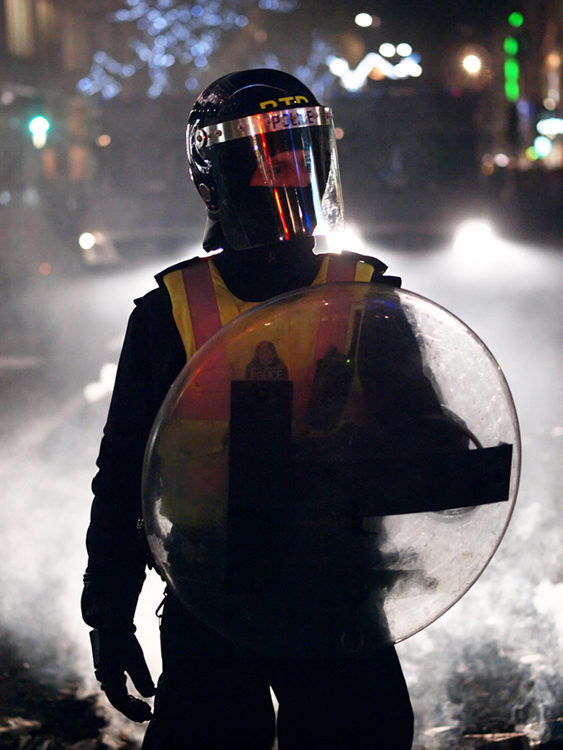| << Chapter < Page | Chapter >> Page > |
Fourth, precipitating factors spur collective behavior; this is the emergence of a dramatic event. The fifth condition is mobilization for action , when leaders emerge to direct a crowd to action. The final condition relates to action by the agents. Called social control , it is the only way to end the collective behavior episode (Smelser 1962).
A real-life example of these conditions occurred after the fatal police shooting of teenager Michael Brown, an unarmed eighteen-year-old African American, in Ferguson, MO on August 9, 2014. The shooting drew national attention almost immediately. A large group of mostly black, local residents assembled in protest—a classic example of structural conduciveness. When the community perceived that the police were not acting in the people's interest and were withholding the name of the officer, structural strain became evident. A growing generalized belief evolved as the crowd of protesters were met with heavily armed police in military-style protective uniforms accompanied by an armored vehicle. The precipitating factor of the arrival of the police spurred greater collective behavior as the residents mobilized by assembling a parade down the street. Ultimately they were met with tear gas, pepper spray, and rubber bullets used by the police acting as agents of social control. The element of social control escalated over the following days until August 18, when the governor called in the National Guard.

Interactionist sociologist Clark McPhail (1991) developed assembling perspective , another system for understanding collective behavior that credited individuals in crowds as rational beings. Unlike previous theories, this theory refocuses attention from collective behavior to collective action. Remember that collective behavior is a noninstitutionalized gathering, whereas collective action is based on a shared interest. McPhail’s theory focused primarily on the processes associated with crowd behavior, plus the lifecycle of gatherings. He identified several instances of convergent or collective behavior, as shown on the chart below.
| Type of crowd | Description | Example |
|---|---|---|
| Convergence clusters | Family and friends who travel together | Carpooling parents take several children to the movies |
| Convergent orientation | Group all facing the same direction | A semi-circle around a stage |
| Collective vocalization | Sounds or noises made collectively | Screams on a roller coaster |
| Collective verbalization | Collective and simultaneous participation in a speech or song | Pledge of Allegiance in the school classroom |
| Collective gesticulation | Body parts forming symbols | The YMCA dance |
| Collective manipulation | Objects collectively moved around | Holding signs at a protest rally |
| Collective locomotion | The direction and rate of movement to the event | Children running to an ice cream truck |
As useful as this is for understanding the components of how crowds come together, many sociologists criticize its lack of attention on the large cultural context of the described behaviors, instead focusing on individual actions.
Collective behavior is noninstitutionalized activity in which several people voluntarily engage. There are three different forms of collective behavior: crowd, mass, and public. There are three main theories on collective behavior. The first, the emergent-norm perspective, emphasizes the importance of social norms in crowd behavior. The next, the value-added theory, is a functionalist perspective that states that several preconditions must be in place for collective behavior to occur. Finally the assembling perspective focuses on collective action rather than collective behavior, addressing the processes associated with crowd behavior and the lifecycle and various categories of gatherings.
Discuss the differences between a mass and a crowd. What is an example of each? What sets them apart? What do they share in common?
Can you think of a time when your behavior in a crowd was dictated by the circumstances? Give an example of emergent-norm perspective, using your own experience.
Discuss the differences between an acting crowd and a collective crowd. Give examples of each.
Imagine you are at a rally protesting nuclear energy use. Walk us through the hypothetical rally using the value-added theory, imagining it meets all the stages.
Blumer, Herbert. 1969. “Collective Behavior.” Pp. 67–121 in Principles of Sociology , edited by A.M. Lee. New York: Barnes and Noble.
LeBon, Gustave. 1960 [1895]. The Crowd: A Study of the Popular Mind . New York: Viking Press.
Lofland, John. 1993. “Collective Behavior: The Elementary Forms.” Pp. 70–75 in Collective Behavior and Social Movements , edited by Russel Curtis and Benigno Aguirre. Boston: Allyn and Bacon.
McPhail, Clark. 1991. The Myth of the Madding Crowd . New York: Aldine de Gruyter.
Smelser, Neil J. 1963. Theory of Collective Behavior . New York: Free Press.
Turner, Ralph, and Lewis M. Killian. 1993. Collective Behavior . 4th ed. Englewood Cliffs, N. J., Prentice Hall.

Notification Switch
Would you like to follow the 'Introduction to sociology 2e' conversation and receive update notifications?